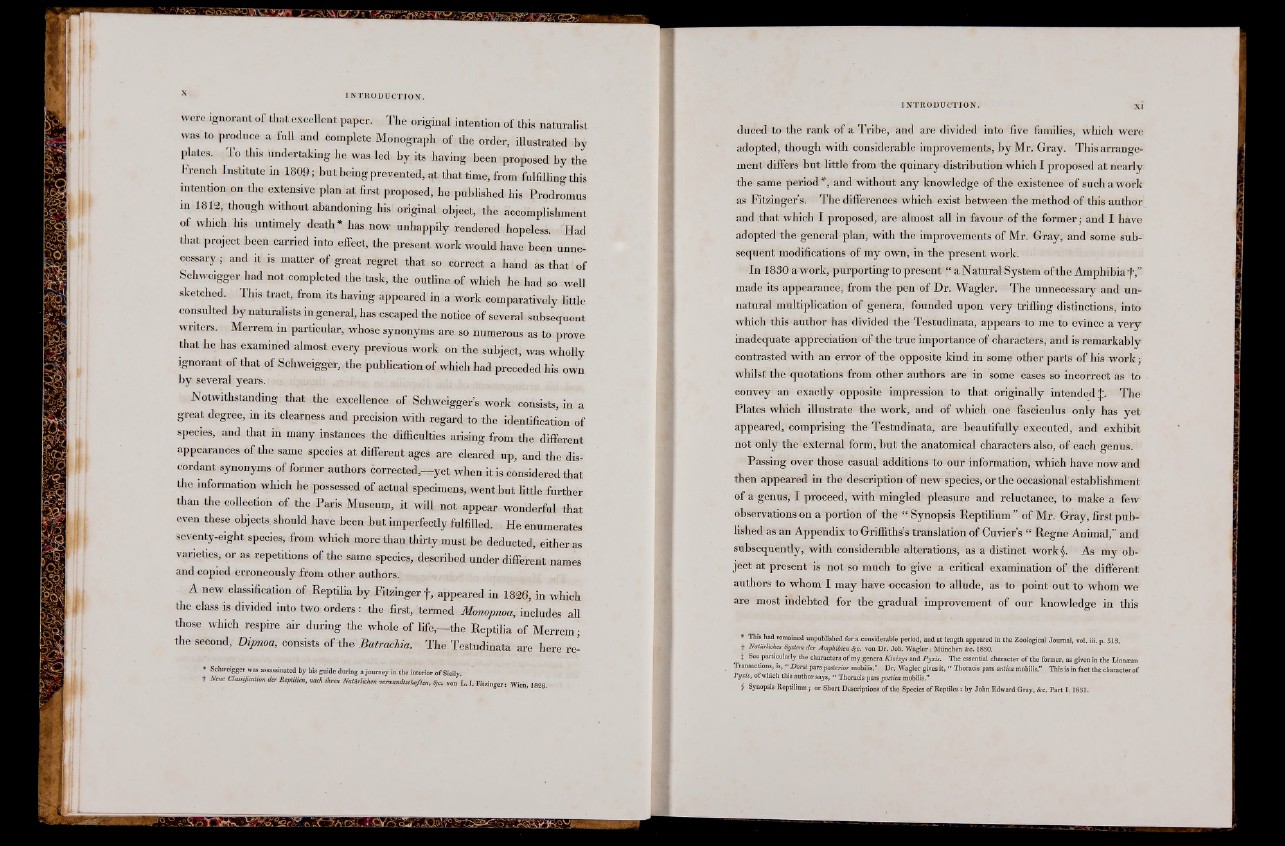
were ignorant of that excellent paper. The original intention of this naturalist
was to produce a full and complete Monograph of the order, illustrated by
plates. To this undertaking he was led, by its having been proposed by the
French Institute in 1809; but being prevented, at that time, from fulfilling this
intention on the extensive plan at first proposed, he published his Prodromus
in 1812, though without abandoning his original object, the accomplishment
of which his untimely death* has now unhappily rendered hopeless. Had
that project been carried into effect, the present work would have; been unnecessary;
and it is matter of great regret that so correct a hand as that of
Schweigger had not completed the task, the outline of which he. had so well
sketched. This tract, from its having appeared in a work comparatively little
consulted by naturalists in general, has escaped the notice of several subsequent
writers. Merrem in particular, whose synonyms are, so numerous as to prove
that he has examined almost every previous work on the subject, was; wholly
ignorant of that of Schweigger, „the publication of which had preceded his. own
by several years.
Notwithstanding that the excellence of Schweigger« work consists, in a
great degree, in its clearness and precision with regard to the [identification of
species, and that in many instances, the difficulties arising from the different
appearances of the same species at different ages are cleared up, and the discordant
synonyms of former authors corrected,—yet when it is considered that
the information which he possessed of actual specimens, went but little further
than the collection of the Paris Museum, it will not appear wonderful that
even these objects, should have been but imperfectly fulfilled. He enumerates
seventy-eight species; from which more than thirty must be deducted, either as
varieties, or as repetitions of the same species, described under different names
and copied erroneously from other authors.
A new classification of Reptilia by Fitzinger f, appeared in 1826, in which
the class is divided into two orders : the,first, termed Monopnoa, includes all
those which respire air during the whole of life,—the Reptilia of Merrem;
the second, Dipnoa, consists of th^Batrachia. The Testudinata are here re-
* Schweigger was assassinated by his guide during a journey in the interior of Sicijy, -
t Neue Classification der Reptilicn, nach ihren NatUrlichen veriuantltschaflcn, S,-c. von L. I. Fitzinger: Wien, 1826.
duced to the rank of a Tribe, and are divided into five families, which were
adopted, though with considerable improvements, by Mr. Gray. This arrangement
differs but little from the quinary distribution which I proposed at nearly
the same period*, ¡and without any knowledge of the existence of such a work
as Fitzinger sr The differences which exist between the method of this author
and that which I proposed, are almost all in favour of the former; and I have
adopted the general plan, with the improvements of Mr. Gray, and some subsequent
modifications of my own, in the present work.
In 1830 a work, purporting to present “ aN atural System of the Amphibia +,”
made its appearance; from the pen of Dr. Wagler. The unnecessary and unnatural
multiplication of genera, founded upon very trifling distinctions, into
which this author has divided the Testudinata, appears to me to evince a very
inadequate appreciation of the true importance of characters, and is remarkably
contrasted with an error of the opposite kind in some other parts of his work;
whilst the quotations from other authors are in some cases so incorrect as to
convey an exactly -opposite impression to that originally intended The
Plates which illustrate the work, and of which one fasciculus only has yet
appeared, comprising the Testudinata, are beautifully executed, and exhibit
not only the external form, but the anatomical characters also, of each genus.
Passing over thosC casual additions to our information, which have now and
then appeared in the description of new species, or the occasional establishment
of a genus; I proceed, with mingled pleasure and reluctance; to make a few
observations on a portion of the “ Synopsis Reptilium ” of Mr. Gray, first published
as an Appendix to Griffiths’s translation of Cuvier’s “ Regne Animal,” and
subsequently, with considerable alterations, as a distinct work§. As my object
at present is not so much to give a critical examination of the different
authors to whom I may have-occasion to allude, as to point out to whom we
are most indebted for the gradual improvement of our knowledge in this
* This had remained unpublished for a considerable period, and at length appeared in the Zoological Journal, vol. iii, p. 513,
f Natürliches System der Amphibien ¿yc. von Dr. Joh. Wagler: München &c. 1830.
t ®ee particularly the characters of my genera Kinixys and Pyxis. The essential character of the former, as given in the Linn«an
Transactions, is, “ Z>ora pars posterior mobilis.” Dr. Wagler gives it, “ Thoracis pars antica mobilis.” This is in fact the character of
Pyxis, of which this author says, “ Thoracis pars postica mobilis."
§ Synopsis Reptilium 5 or Short Descriptions of the Species of Reptiles: by John Edward Gray, &c. Part 1 .1831.